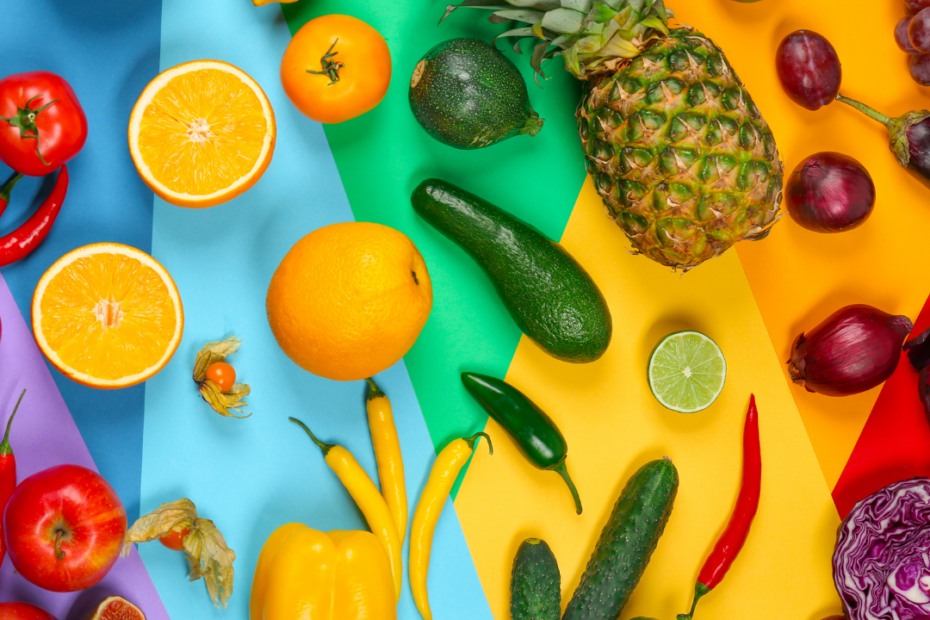Spring is officially in the air! Every new season is an opportunity to reset and refocus our minds and our bodies. This spring we are focusing on eating the rainbow and filling our plates with lots of new flavors and in-season vegetables. Eating the rainbow means incorporating fruits and vegetables of all colors into our meals each day. Fruits and vegetables contain phytonutrients which act as antioxidants, play specific roles in helping maintain our health, and give each fruit or vegetable its unique color. While fruit and veggie consumption is beneficial to our health in and of itself, focusing on eating a variety of colors is a simple way to increase our intake of a wide range of vitamins, minerals and phytonutrients. We’ve put together a list of in-season fresh foods to try this spring and included a few of our favorite ways to incorporate each fruit or vegetable below!
In-Season Vegetables for Spring:
- Artichokes – bring an artichoke dip to your next social gathering. We love this healthy, vegan spinach artichoke dip for a spring BBQ.
- Arugula – mix up your salad-game with these easy recipes – arugula salad with shaved parmesan (three ways!).
- Beets – whole beets can be tricky and time-consuming to prepare. To avoid the mess, there are lots of ready-to-eat store-bought options to choose. Our favorite brand is Love Beets.
- Asparagus – our go-to way to prep asparagus is to simply toss them in olive oil, salt and pepper and throw them on the grill or in the oven. Check out this easy-to-follow roasted asparagus recipe along with some ideas for flavors that will completement your roasted asparagus.
- Carrots – with Easter right around the corner, now is the perfect time to perfect your carrot recipe! This roasted carrot recipe is flavorful and colorful!
- Leafy greens
- Kale – not a fan of raw kale? Try this sauteed kale recipe for your next side dish!
- Dandelion Greens – this can feel like a tricky green to get used to, but this sauteed dandelion greens with eggs, leeks and feta will have you falling for dandelion greens in no time.
- Chard – switch up your greens with this simple sauteed swiss chard recipe.
In-Season Fruits for Spring:
- Cherries – packed with nutrients and full of fiber, grab a handful on the go for a quick and easy snack.
- Grapefruit – we love having a side of grapefruit with our breakfast. Not sure of the best way to cut a grapefruit? Here’s an easy guide.
- Lemons – a simple squeeze of lemon or a sprinkle of lemon zest is a nutrient-packed way to spice up any meal or recipe!
- Rhubarb – rhubarb can be eaten pickled in a salad,baked in a crisp or slow roasted as a side dish. Check out this incredible list of rhubarb recipes to try this spring!
- Strawberries – great on their own, in a smoothie, or mixed in with some yogurt and granola!
- Kumquats – kumquats are a citrus fruit from the orange family that are best eaten in-season when their sweet-tart citrus flavor really comes through. They can be eaten raw and whole or cooked into a jam or a marmalade. Here are three easy ways to use kumquats!
Farms in the local area offer for purchase weekly shares of what grows on the farm. Here is a link to local farms offering Community Supported Agriculture: https://www.localharvest.org/waltham-ma/csa.
Eating in-season has many benefits to both our health and our wallets. Choosing in-season whole foods is generally cheaper than sourcing out-of-season fruits and vegetables as it does not require outsourcing to other regions or countries. Eating in-season also encourages eating locally which helps to support our local communities, farms and businesses.
Fruits and vegetables eaten in-season foods are typically more nutrient-dense than out-of-season foods, providing us with foods that are richer in vitamins, minerals, phytonutrients and fiber. Challenge yourself this spring by incorporating lots of colors into your meals each day, and choosing one new in-season fruit or vegetable to try each week!
Content submitted by Jessica Roy MS, RD, LDN Waverley Oaks Registered Dietitian and Nutrition Counselor, and Caroline Meyer, Nutrition Intern
